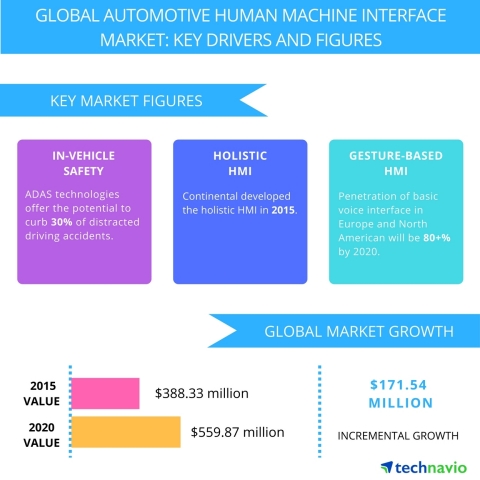
Technavio publishes a new market research report on the global automotive human machine interface market from 2016-2020. (Graphic: Business Wire)
The research study covers the present scenario and growth prospects of the global automotive HMI market for 2016-2020. To calculate the market size, the report considers the revenue of automotive HMI systems across all regions. It also presents the vendor landscape and a corresponding detailed analysis of the top five vendors in the market.
HMI is a vital component for enabling rich infotainment features in addition to safety features in the vehicles. Hence, they are mostly preferred by the vehicles for long distance traveling. The HMI provides voice notifications, alerts, and visuals for functions like the Internet, GPS navigation, and information. The HMI provides these added benefits to the vehicles, where the HMI systems facilitate long distance travel. Hence, they are widely adopted in America and Europe, where touring vehicle penetration is high. APAC is dominated by the traditional low segment vehicles. This is owing to the preference for vehicles required for daily commuting, instead of long distance traveling. In addition, HMI has high penetration in high-end vehicles, which constitutes lower percentage in APAC.
Request a sample report: http://www.technavio.com/request-a-sample?report=54504
Technavio’s sample reports are free of charge and contain multiple sections of the report including the market size and forecast, drivers, challenges, trends, and more.
Technavio automotive analysts highlight the following three factors that are contributing to the growth of the global automotive HMI market:
- High co-relation between consumer electronics and HMI system with components generating economies of scale
- Integration of smartphones with vehicles boosting demand for HMI
- Government intervention to increase in-vehicle safety will push demand for HMI system
High co-relation between consumer electronics and HMI system with components generating economies of scale
The economies of scale play an important role in today’s market. It is needed to leverage the use of technology to maximum customers. For instance, adoption of smartphones across the world increased significantly in last 4-5 years owing to the reduced price. This price reduction was fueled by the advantage of economies of scale to smartphone manufacturers due to increased production.
Siddharth Jaiswal, a lead automotive electronics analyst at Technavio, says, “Hardware cost remains a primary consideration for OEMs, and by keeping a close eye on consumer electronics the OEMs are able to adopt new technology in cost effective way. Additionally, when any technology is adopted in consumer electronics, its volume grows, and that drives the prices down in the market, which accounts for the benefits of the automotive market.”
Integration of smartphones with vehicles boosting demand for HMI
The evolution of the trend of connectivity in vehicles has resulted in consumers connecting their smartphones and tablets to the vehicles' infotainment systems. For instance, Apple's car integration Carplay and Android Auto are used widely by automotive OEMs in their infotainment systems to allow drivers to connect their smartphones to the car.
“Hyundai Blue Link infotainment systems mirror a smartphone on a vehicle's display screen through an interface or Bluetooth. Also, GM empowered its MyLink and IntelliLink infotainment systems to support applications developed by third parties,” adds Siddharth.
Government intervention to increase in-vehicle safety will push demand for HMI system
Governments worldwide have increased their efforts to improve safety standards and environmental conditions. Hence, telematics services such as e-call and emergency road assistance - global navigation satellite system (ERA-GLONASS) are increasingly being adopted, which in turn is leading to increased adoption of HMI systems. Government agencies are increasingly placing more focus on preventing distracted driving, so regulation of the automotive industry and its output has increased.
The focus towards the adoption of safety technologies like advanced driver assistance systems (ADAS) is also another factor contributing to the adoption of HMI. For instance, ADAS technologies offer the potential to curb 30% of all these accidents while autonomous technologies can curb by 90%. While ADAS contribute to the curbing of accidents, the ability of the automotive reconfigurable instrument cluster that is likely to assist the driver with easier information processing of in-vehicle systems.
Top vendors:
- Alpine Electronics
- Continental
- Delphi
- Denso
- Valeo
Browse Related Reports:
- Global Human Machine Interface Market 2016-2020
- Global Automotive Infotainment Market 2016-2020
- Global Commercial Vehicle Advance Driver Assistance Systems Market 2016-2020
Do you need a report on a market in a specific geographical cluster or country but can’t find what you’re looking for? Don’t worry, Technavio also takes client requests. Please contact enquiry@technavio.com with your requirements and our analysts will be happy to create a customized report just for you.
About Technavio
Technavio is a leading global technology research and advisory company. The company develops over 2000 pieces of research every year, covering more than 500 technologies across 80 countries. Technavio has about 300 analysts globally who specialize in customized consulting and business research assignments across the latest leading edge technologies.
Technavio analysts employ primary as well as secondary research techniques to ascertain the size and vendor landscape in a range of markets. Analysts obtain information using a combination of bottom-up and top-down approaches, besides using in-house market modeling tools and proprietary databases. They corroborate this data with the data obtained from various market participants and stakeholders across the value chain, including vendors, service providers, distributors, re-sellers, and end-users.


